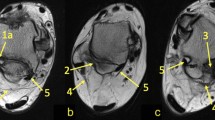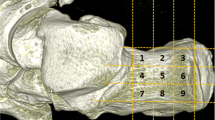Abstract
Purpose
The aim of this study is to investigate the detailed anatomy of the posterior talofibular ligament (PTFL) on MR images in patients with os trigonum. We also evaluated the pathological conditions of the PTFL, anterior talofibular ligament (ATFL), flexor hallucis longus (FHL) tendon, talus and os trigonum.
Methods
Ankle MRIs of 70 patients with os trigonum (study group) and 70 patients without it (control group) were reviewed for the anatomy of the anterior and posterior fibers of PTFL. The prevalence of PTFL and ATFL pathologies was also compared between two groups. Additionally FHL tenosynovitis and osseous pathologies were evaluated.
Results
The posterior fibers inserted into the lateral tubercule of the posterior process of the talus in the control group whereas if an os trigonum was present, the posterior fibers of PTFL were inserted only into the os trigonum. The origins of anterior and posterior fibers were the medial surface of the lateral malleolus and the insertion of the anterior fibers was lateral surface of the talus posterior to the lateral malleolar facet in both groups. There was a significant association between an abnormal PTFL, ATFL and the presence of os trigonum. FHL tenosynovitis was higher in the study group but it did not meet the statistical significance. The most common pathology of the talus and os trigonum was subchondral edema along the synchondrosis.
Conclusions
In patients with os trigonum, the posterior fibers of the PTFL were inserted herein. In the case of an os trigonum signal alterations of ligaments were more common, which may reflect chronic instability.






Similar content being viewed by others
References
Cerezal L, Abascal F, Canga A et al (2003) MR imaging of ankle impingement syndromes. AJR 181:551–559
Courvoisier A, Vialle R, Thevenin-Lemoine C, Mary P, Damsin JP (2008) The posterior talofibular ligament: an anatomical study with clinical implication in clubfoot surgery. Surg Radiol Anat 30:633–637
Golano P, Vega J, De Leeuw PAJ et al (2010) Anatomy of the ankle ligaments: a pictorial essay. Knee Surg Sports Traumatol Arthrosc 18:557–569
Gossner J (2010) Visibility of the lateral collateral ligaments in routine computed tomography of the ankle. Surg Radiol Anat 4:417–418
Grogan DP, Walling AK, Ogden JA (1990) Anatomy of the os trigonum. J Pediatr Orthop 10:618–622
Hamilton WG (1982) Stenosing tenosynovitis of the flexor hallucis longus tendon and posterior impingement upon the os trigonum in ballet dancers. Foot Ankle 3:74–80
Hua J, Xu JR, Gu HY et al (2008) Comparative study of the anatomy, CT and MR images of the lateral collateral ligaments of the ankle joint. Surg Radiol Anat 30:361–367
Lee KM, Chung CY, Kwon SS et al (2013) Relationship between stress ankle radiographs and injured ligaments on MRI. Skeletal Radiol 42:1537–1542
Lo LD, Schweitzer MR, Fan JK et al (2001) MR imaging findings of entrapment of the flexor hallucis longus tendon. AJR Am J Roentgenol 176:1145–1148
Maquirriain J (2005) Posterior ankle impingement syndrome. J Am Acad Orthop Surg 13:365–371
McDougall A (1955) The os trigonum. J Bone Joint Surg 37:257–265
Peace KAL, Hilier JC, Hulme A, Healy JC (2004) MRI Features of posterior ankle impingement syndrome in ballet dancers: a review of 25 cases. Clin Radiol 59:1025–1033
Sammarco GJ, Cooper PS (1998) Flexor hallucis longus tendon injury in dancers and nondancers. Foot Ankle 19:356–362
Sanhudo JA (2002) Stenosing tenosynovitis of the flexor hallucis longus tendon at the sesamoid area. Foot Ankle Int 23:801–803
Schweitzer ME, Van Leersum M, Ehrlich SS et al (1994) Fluid in normal and abnormal ankle joints: amount and distribution as seen on MR images. AJR Am J Roentgenol 162:111–114
Conflict of interest
The authors declare that they have no conflict of interest.
Author information
Authors and Affiliations
Corresponding author
Rights and permissions
About this article
Cite this article
Gursoy, M., Dag, F., Mete, B.D. et al. The anatomic variations of the posterior talofibular ligament associated with os trigonum and pathologies of related structures. Surg Radiol Anat 37, 955–962 (2015). https://doi.org/10.1007/s00276-015-1428-5
Received:
Accepted:
Published:
Issue Date:
DOI: https://doi.org/10.1007/s00276-015-1428-5




